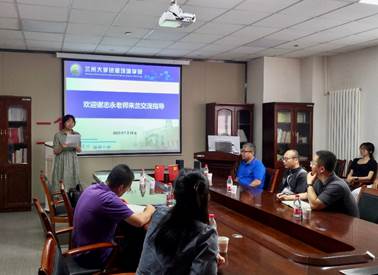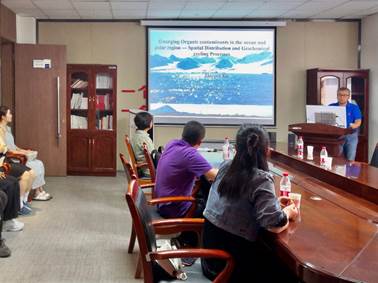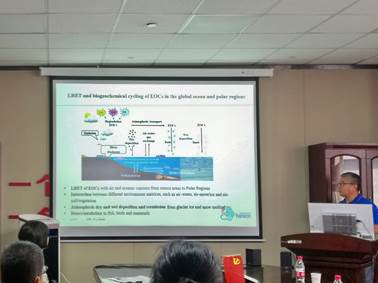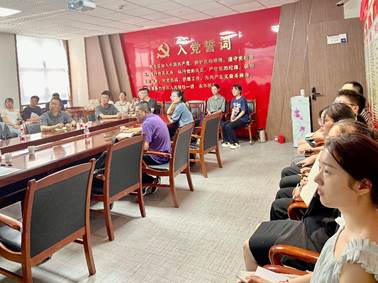On July 18, 2023, at the invitation of Professor Ma Jianmin and Professor Gao Hong from the College of Earth and Environmental Sciences of Lanzhou University and Key Laboratory of Environmental Pollution Warning and Control in Gansu Province, Professor Xie Zhiyong from the Institute of Coastal Environmental Chemistry of Helmholtz-Zentrums Hereon (Germany) came to our university for academic exchanges and gave a lecture entitled "Novel Organic Pollutants in the Marine and Polar Environments". The presentation was hosted by Professor Gao Hong from the College of Earth and Environmental Sciences of Lanzhou University, and nearly 60 teachers and graduate students from Department of Environmental Science and Engineering attended the presentation either offline or online.


The source-sink relationship of new organic pollutants present in higher concentrations in polar and marine environments has become a hot research area in current environmental science. Researcher Xie Zhiyong firstly introduced the traditional Persistent Organic Pollutants (POPs) and some new POPs currently included in the list of Stockholm Convention on Persistent Organic Pollutants (POPs), including polychlorinated biphenyls (PCBs), Hexabromocyclododecane (HBCD), perfluorinated and polyfluorinated alkyl compounds (PFACs), medium and long chain chlorinated paraffins (MCCPs), gotta clones and so on. Subsequently, researcher Xie Zhiyong introduced the concentration levels of new organic pollutants in clean oceans and polar regions and their long-range environmental transport processes from land source areas to polar regions via atmospheric and oceanic currents, as well as the methodological approaches for environmental observation of new organic pollutants in global oceanic seawater and the atmosphere from polar research vessels; and quantitatively analyzed the exchange processes, fate fluxes, and source fluxes of new organic pollutants between air and seawater, in conjunction with the air-sea interfacial exchange model. Studies have shown that the re-release of traditional persistent and new organic pollutants that have been remotely transported to glaciers, sea ice and snow, especially under warming, may significantly increase atmospheric and seawater concentrations and amplify ecological and health risks in the polar regions. Future research should focus on various biogeochemical and geophysical processes under the dual factors of climate change and human activities. Finally, Professor Xie Zhiyong shared the interesting stories of his team's research work in the polar regions in the form of pictures and videos, which aroused the students' curiosity and strong interest in polar research.


The report of Professor Xie Zhiyong richly covered the contents and conclusions of the scientific research on new organic pollutants in the ocean and polar regions and broadened the horizons of the participating students and teachers in the hot research areas of new organic pollutants in the global marine and terrestrial environments. After the presentation, Professor Xie Zhiyong discussed and interacted with many students and faculty members on the observation of organic pollutants in the marine and terrestrial environments, the spatial distribution of organic pollutants and geochemical cycling processes, and other related academic issues.
Expert Profile:
Xie Zhiyong, Researcher and Doctoral supervisor at Helmholtz Centre for Coastal Research, Germany, and Vice-chairman of the Working Group on Persistent Organic Pollutants (ImPACT) of the Antarctic Science Committee (https://www.scar.org/). He has long been working on the environmental and biogeochemical behavior of conventional and novel organic pollutants in different environmental media. He has participated in many scientific expeditions to the South and Arctic and has made remarkable achievements in research on the persistence and long-range transport mechanisms of organic pollutants in coastal zone, marine and polar environments. Researcher Xie Zhiyong is an international leader in the study of global novel organic pollutants (perfluorinated compounds, novel brominated and phosphorous flame retardants, and currently used pesticides, as well as pharmaceuticals and personal care products) in the coastal-oceanic-polar regions. He applied multi-media modeling to elucidate the biogeochemical cycling of novel organic pollutants in polar regions as a result of climate change and enhanced human activities.